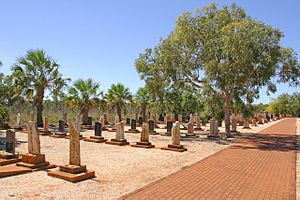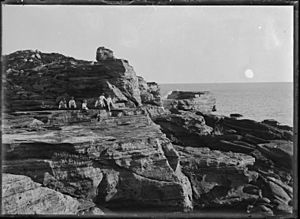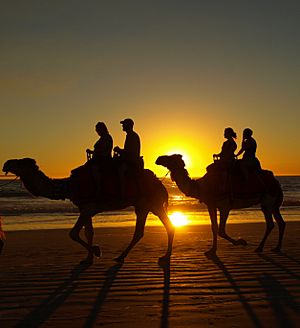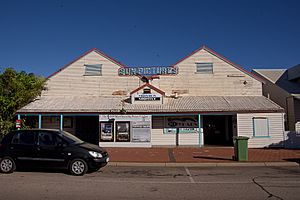Broome, Western Australia facts for kids
Quick facts for kids BroomeWestern Australia |
|||||||||
|---|---|---|---|---|---|---|---|---|---|
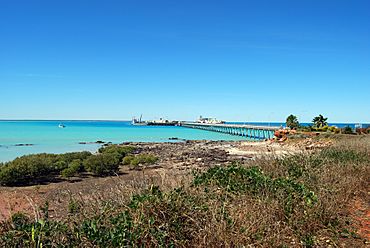
Broome jetty
|
|||||||||
| Population | 13,984 (2016 census) | ||||||||
| Established | 1883 | ||||||||
| Postcode(s) | 6725 | ||||||||
| Elevation | 19 m (62 ft) | ||||||||
| Time zone | AWST (UTC+08:00) | ||||||||
| Location | 1,681 km (1,045 mi) NNE of Perth | ||||||||
| LGA(s) | Shire of Broome | ||||||||
| State electorate(s) | Kimberley | ||||||||
| Federal Division(s) | Durack | ||||||||
|
|||||||||
Broome, also known as Rubibi by the Yawuru people, is a coastal, pearling and tourist town in the Kimberley region of Western Australia, 1,681 km (1,045 mi) north of Perth. The estimated urban population was 13,984 in August 2016. It is the largest town in the Kimberley region.
Contents
History
Broome is situated on the traditional lands of the Yawuru people.
It is often mistakenly thought that the first European to visit Broome was William Dampier in 1688, but he only visited the north of what was later named the Dampier Peninsula. In 1699 he explored the coast from Shark Bay to La Grange Bay, from where he headed north leaving the Australian coast. Many of the coastal features of the area were later named for him. In 1879, Charles Harper suggested that the pearling industry could be served by a port closer to the pearling grounds and that Roebuck Bay would be suitable. In 1883, John Forrest chose the site for the town, and it was named after Sir Frederick Broome, the Governor of Western Australia from 1883 to 1889.
In 1889, a telegraph undersea cable was laid from Broome to Singapore, connecting to England. Hence the name Cable Beach given to the landfall site.
Pearling Industry
The town has a deep history based around the exploits of the men and women who developed the pearling industry, starting with the harvesting of oysters for mother of pearl in the 1880s to the current major cultured pearl farming enterprises.
At first, aborigines were blackbirded (enslaved) and forced to dive naked, with little or no equipment.
When slavery was abolished and diving suits were needed for deeper diving, Asians and islanders were given the dangerous job instead. Especially Japanese were valued for their experience. The riches from the pearl beds did not come cheaply, however, and the town's Japanese cemetery is the resting place of 919 Japanese divers who lost their lives working in the industry. Many more were lost at sea, and the exact number of deaths is unknown. The Japanese were only one of the major ethnic groups who flocked to Broome to work on the luggers or the shore based activities supporting the harvesting of oysters from the waters around Broome. They were specialist divers and, despite being considered enemies, became an indispensable part of the industry until World War II.
Each year Broome celebrates this fusion of different cultures in an annual cultural festival called Shinju Matsuri (Japanese for festival of the pearl) which celebrates the Asian influenced culture brought there by the pearling industry.
Recent history
-
Main page: Attack on Broome
Broome was attacked at least four times by Japanese aircraft during World War II. The worst attack in terms of loss of life was an air raid on 3 March 1942 in which at least 86 people (mostly civilian refugees from the Dutch East Indies) were killed. Twenty-two aircraft were destroyed, most of them flying boats, the remains of which can still be seen in the harbour at low tide.
In 1950, Broome was the setting for Arthur Upfield's novel "The Widows of Broome", his 12th novel featuring Detective Inspector Napoleon Bonaparte ('Bony').
The West Australian mining boom of the 1960s, as well as the growth of the tourism industry, also helped Broome develop and diversify.
At Gantheaume Point and 30 m (98 ft) out to sea are dinosaur footprints dated as Early Cretaceous in age (approximately 130 million years ago). The tracks can be seen only during very low tide. In 1996 some of the prints were cut from the ground and stolen, but have since been recovered. Plant fossils are also preserved extensively in the Broome Sandstone at Gantheaume Point and in coastal exposures further north.
Racial segregation was common in Broome until the 1970s.
Broome entered into a sister city agreement with Taiji, Japan in 1981 as historic ties between the two towns date back to the early 1900s, when Japan became instrumental in laying the groundwork of Broome's pearling industry. The annual dolphin hunt in Taiji was the subject of the 2009 documentary The Cove, and sparked a unanimous decision by Broome's council, headed by Graeme Campbell, to end the relationship with Taiji if the dolphin hunt were to continue. The decision was reversed in October 2009.
Cable Beach
Named in honour of the Java-to-Australia undersea telegraph cable which reaches shore there, Cable Beach is situated 7 km (4.3 mi) from town along a bitumen road. The beach itself is 22.5 km (14.0 mi) long with white sand, washed by tides that can reach over 9 m (30 ft). The beach is almost perfectly flat. Caution is required when swimming from November to March as box jellyfish are present during those months. There have been cases where crocodiles have been sighted off the shore, but this is a rarity and measures are taken to prevent these situations. Four wheel drive vehicles may be driven onto the beach from the car park. This allows people to explore the beach at low tide to a much greater extent than would be possible on foot. Sunset camel rides operate daily along the beach.
Located directly east of Cable Beach over the dunes is Minyirr Park, a coastal reserve administered by a collaboration of the Shire of Broome and the Yawuru people.
Roebuck Bay
Being situated on a north/south peninsula, Broome has water on both sides of the town. On the eastern shore are the waters of Roebuck Bay extending from the main jetty at Port Drive to Sandy Point, west of Thangoo station. Town Beach is part of the shoreline and is popular with visitors on the eastern end of the town. It is also the site of the famous 'Staircase to the Moon', where a receding tide and a rising moon combine to create a stunning natural phenomenon. On 'Staircase to the Moon' nights, a food and craft market is operated on Town Beach.
Roebuck Bay is of international importance for the millions of migrating waders or shorebirds that use it seasonally on migration through the East Asian – Australasian Flyway from their breeding grounds in northern Asia. They feed on the extensive intertidal mudflats and roost at high tide on the red sand beaches of the bay. They can be seen in the largest numbers in summer, but many of the younger birds remain throughout the first and second years of their lives. The Broome Bird Observatory, sited in pindan woodland close to the northern shore of Roebuck Bay, was established by Birds Australia in 1988, and formally opened in 1990. The purpose of the observatory is to study the birds, learn how to protect them and educate the public about them.
A mixed black flying fox and little red flying fox colony of around 50,000 megabats lives all year in mangroves next to Broome township's small Streeter's Jetty. They chatter and socialise loudly before flying out at dusk each evening. The bats are key pollinators and seed dispersers for native trees and plants.
Climate
Under the Köppen climate classification, Broome has a semi-arid climate (BSwhg), like most parts of the Australian tropics, it has two seasons: a dry season and a wet season. The dry season is from April to November with nearly every day clear and maximum temperatures around 30 °C (86 °F). The wet season extends from December to March, with maximum temperatures of around 35 °C (95 °F), rather erratic tropical downpours and high humidity. Broome's annual rainfall average is 615.1 mm (24.22 in), 75% of which falls from January to March.
Broome is susceptible to tropical cyclones and these, along with the equally unpredictable nature of summer thunderstorms, play a large part in the erratic nature of the rainfall. For instance, in January 1922, Broome Post Office recorded just 2.8 mm (0.11 in) of rainfall while in the same month of 1997, the airport received 910.8 mm (35.86 in). Dewpoint averages at 24 °C in the wet season and is as low as 8.4 °C in the dry season.
Frost is unknown; however, temperatures during the cooler months have dropped to as low as 3.3 °C (37.9 °F).
Broome observes an average of 48.4 days a year that record measurable precipitation.
| Climate data for Broome Airport | |||||||||||||
|---|---|---|---|---|---|---|---|---|---|---|---|---|---|
| Month | Jan | Feb | Mar | Apr | May | Jun | Jul | Aug | Sep | Oct | Nov | Dec | Year |
| Record high °C (°F) | 44.1 (111.4) |
42.7 (108.9) |
42.2 (108.0) |
41.0 (105.8) |
38.7 (101.7) |
36.2 (97.2) |
36.0 (96.8) |
37.8 (100.0) |
41.3 (106.3) |
42.8 (109.0) |
44.3 (111.7) |
44.8 (112.6) |
44.8 (112.6) |
| Average high °C (°F) | 33.3 (91.9) |
32.9 (91.2) |
33.9 (93.0) |
34.3 (93.7) |
31.5 (88.7) |
29.1 (84.4) |
28.8 (83.8) |
30.3 (86.5) |
31.8 (89.2) |
32.9 (91.2) |
33.6 (92.5) |
33.8 (92.8) |
32.2 (90.0) |
| Average low °C (°F) | 26.3 (79.3) |
26.0 (78.8) |
25.4 (77.7) |
22.6 (72.7) |
18.2 (64.8) |
15.1 (59.2) |
13.7 (56.7) |
14.2 (57.6) |
18.5 (65.3) |
22.3 (72.1) |
25.1 (77.2) |
26.5 (79.7) |
21.2 (70.2) |
| Record low °C (°F) | 19.0 (66.2) |
15.2 (59.4) |
16.0 (60.8) |
12.6 (54.7) |
7.7 (45.9) |
5.2 (41.4) |
3.3 (37.9) |
3.8 (38.8) |
8.9 (48.0) |
13.3 (55.9) |
16.7 (62.1) |
17.4 (63.3) |
3.3 (37.9) |
| Average rainfall mm (inches) | 181.6 (7.15) |
179.8 (7.08) |
101.7 (4.00) |
26.2 (1.03) |
27.3 (1.07) |
19.9 (0.78) |
7.1 (0.28) |
1.7 (0.07) |
1.4 (0.06) |
1.5 (0.06) |
9.2 (0.36) |
57.7 (2.27) |
615.1 (24.21) |
| Average rainy days (≥ 0.2 mm) | 11.5 | 11.4 | 8.1 | 2.6 | 2.5 | 1.8 | 1.3 | 1.0 | 1.1 | 0.6 | 1.2 | 5.3 | 48.4 |
| Average relative humidity (%) | 65 | 67 | 60 | 45 | 38 | 36 | 33 | 35 | 45 | 54 | 57 | 61 | 50 |
| Mean monthly sunshine hours | 257.3 | 212.8 | 263.5 | 294.0 | 291.4 | 282.0 | 306.9 | 325.5 | 312.0 | 337.9 | 336.0 | 291.4 | 3,510.7 |
Sport and recreation
Broome hosts a lawn bowling club and a golf club. The town has four Australian rules football clubs; Broome Bulls Football Club (established 1949) the Broome Saints, Towns and Cable Beach all competing in the West Kimberley Football Association with games played at Haynes Oval.
Four Association Football clubs compete in the local Broome Soccer Association's BLiga competition each dry season. FC Meatworks, Pearlers, Racing G and Broome Town field sides across men's and women's divisions.
Broome is home to the Sun Picture Garden, the oldest operating open-air cinema in the world.
Broome is considered to be among the best places in the world to catch Sailfish.
Save the Kimberley campaign
The Broome community led a campaign to protest against a proposal to industrialise the James Price Point outside of Broome. The campaign has received ardent support from public figures such as John Butler, Missy Higgins, Clare Bowditch and former leader of the Australian Greens, Dr Bob Brown. A concert for the campaign was held on 5 October 2012 at Federation Square in Melbourne and was attended by approximately 6,000 people. Much of the concern was due to the myriad of well-preserved dinosaur tracks that are found in the intertidal zone outside of Broome. These include possibly the largest known dinosaur footprints, sauropod tracks upwards of 1.7 m long. It is suspected that the sauropod that made these tracks might have been 7–8 m tall at the hip.
Education
Broome contains five schools: four government, Broome Primary School, Cable Beach Primary School, Roebuck Primary School, and Broome Senior High School; and St Mary's College, a Catholic K–12 school.
Transport
Broome International Airport is the regional air hub of northwestern Western Australia and is considered the tourism gateway to the Horizontal Falls and the whole Kimberley region.
The Broome Tramway was an industrial tramway used to convey goods between Mangrove Point and the town centre from 1898 until the 1960s.
See also
 In Spanish: Broome para niños
In Spanish: Broome para niños



